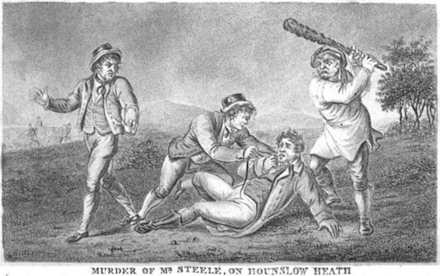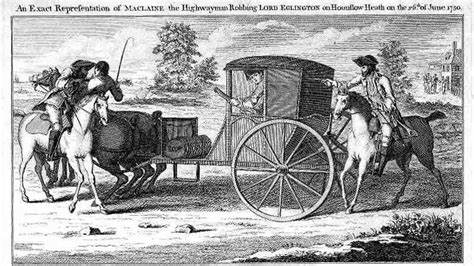
Mr. Steele was a business man, who owned a lavender farm in Feltham and a lavender water warehouse in the Strand on Catherine Street. Mr. Steel was married, 35, and had a townhouse in London.
On a Friday, November 5, 1802 Mr. Steele set out for Feltham. Feltham is southwest of London, a bit past Hounslow Health.
Murder of Mr. Steele: Documents and Observations Tending to Shew a Probability of the Innocence of John Holloway and Owen Haggerty, who Were Executed on Monday the 23d of Febuary [sic] 1807 as the Murderers of the Above Gentleman (1807)
When Mr. Steele did not return home, his friends and family grew anxious. It was discovered, upon investigation, that Mr. Steele had not been able to procure a carriage and was obliged to proceed on foot. Therefore, his friends and family immediately set out on foot travelling the road to find him. It was likely he had travelled through Hounslow Heath, a notourious haunt for highwaymen and robbers.

Searchers first found his bloodstained coat on the health in a gravel pit 10-15 yards off the road (https://www.executedtoday.com/2017/02/23/1807-john-holloway-and-owen-haggerty-sworn-away/). Continuing their search, the party found:
Celebrated Trials, and Remarkable Cases of Criminal Jurisprudence (1825)
Steele’s boots were missing, and his pockets had been cut away from his clothes. The 26 shillings he was carrying was also gone (https://www.executedtoday.com/2017/02/23/1807-john-holloway-and-owen-haggerty-sworn-away/).
Although his family ran an advertisement offering a reward for 50 GBP for information leading to the capture of Mr. Steele’s murder, four years went by with no real hope.
In 1806, a young man of 26 named Benjamin Hanfield was awaiting transportation to Australia, when he let slip information about a murder on Hounslow Heath. Hanfield had fallen seriously ill, and claimed he wanted to unburden his conscious before he died.
Celebrated Trials, and Remarkable Cases of Criminal Jurisprudence (1825)
Hanfield had a detailed account of the night of the murder:
Celebrated Trials, and Remarkable Cases of Criminal Jurisprudence (1825)
There were several improbabilities about Hanfield’s account. First, he had indicated the band of men knew about Steele’s travels ahead of time. As Steele himself had been unsure of his timetable and had been ill prepared enough not to secure a carriage, it was unlikely anyone else would have advanced warnings of his movements. Second, when Haggerty and Holloway were assembled, they denied all knowledge of each other or Hanfield, the murder, or even having ever been to Hounslow Heath.
Haggerty and Holloway went to the gallows at Newgate proclaiming their innocence, while a crowd o an estimated 40,000 people stood watch (https://www.executedtoday.com/2017/02/23/1807-john-holloway-and-owen-haggerty-sworn-away/). The crowd was so packed, that several people died or were seriously injured by trampling or suffocation.
It was later found that the proprietors of multiple establishments Hanfield has said the trio had visited that fateful night did not remember them and, upon further investigation, many of the details recounted by Hanfield were part of broad public gossip. James Harmer’s pamphlet (excerpted above) in 1807 clearly outlined the multiple examples of evidence supporting the innocence of Holloway and Haggerty.
In 1820, another man was indicted for the murder of Mr. Steele. John Ward, alias Simon Winter, had a bad reputation for livestock theft and robbery, and was said to have been part of the search for Mr. Steele and acting suspiciously. That included trying to lead searchers away from discovery of the body.
The case against him was later dismissed for lack of evidence, but what was suddenly clear was that the authorities now very much doubted the guilt of Holloway and Haggerty.









